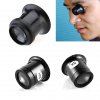"Best" is relative to your purpose, in this case the ability to "see" smaller components. Whether you also need to use your hands to manipulate those components is also a consideration. I would recommend that you start with a
good binocular stereo head-mounted magnifier. I use
Donegan Optical's Optivisor with a 4 diopter pair of precision-ground crown opthalmic glass prismatic lenses. These provide a working distance of about six to ten inches and a magnification of approximately 2X. Your working distance and magnification will depend on how your eyes focus, but lenses are available in 2, 3, 4, 5, 7, and 10 diopter focal lengths, with nominal magnifications and working distances of 1.5X at 20", 1.75X at 14", 2X at 10", 2.5X at 8", 2.75X at 6", and 3.5X at 4" respectively. Notice the working distance decreases substantially as the magnification increases.
I have personally found that a 4 or 7 diopter lens is about the most I can comfortably use while placing and soldering SMD components. A 10 diopter lens is useful for
inspecting components, but the working distance is too small for comfortable use with my hands. I plan to purchase a used stereo zoom microscope, mounted on an adjustable boom arm, after I start doing serious SMD assemblies. I also want to try one of the el-cheapo digital microscopes that use a CCD imager and a small monitor (usually your PC monitor via a USB connection) for display. I suspect these may be difficult to use with good eye-hand coordination because they lack a stereo view with good depth of field, but at a hundred bux or so, it may be worth a try.
Finally, ordinary drug store "reading" glasses are available in various diopters and are relatively inexpensive. What they are not is convenient to use, because you must either remove them or look over the top of them to see distant objects in focus. A flip-up, head-mounted, arrangement is better IMHO, but your mileage (or kilometers) may differ.
If so inclined, with deep pockets, you can also purchase expensive wearable stereo optics with good magnification and depth of field for upwards of a thousand bux... maybe cheaper if imported from China. Surgeons and dentists use these for hands-free viewing while doing their thing to you. They look like space cadets or bug-eyed monsters while wearing them, but they do get the job done.



